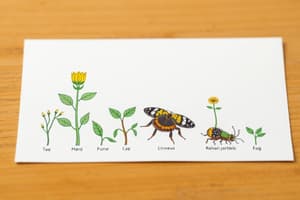Podcast
Questions and Answers
Give two reasons for having a biological classification system.
Give two reasons for having a biological classification system.
1 - For accurate communication between scientists; 2 - It organizes organisms and allows them to be studied in an organized fashion.
Why are Aristotle's and Linnaeus's groupings of living things considered artificial classification systems?
Why are Aristotle's and Linnaeus's groupings of living things considered artificial classification systems?
Because they are based on primarily observable characteristics.
List from largest to smallest the seven basic levels in the modern classification hierarchy.
List from largest to smallest the seven basic levels in the modern classification hierarchy.
Kingdom, Phylum, Class, Order, Family, Genus, Species.
Describe three general rules for using the modern biological classification system.
Describe three general rules for using the modern biological classification system.
List the six kingdoms of living things and give characteristics of each.
List the six kingdoms of living things and give characteristics of each.
What is a domain?
What is a domain?
Give two reasons for having a system of scientific names.
Give two reasons for having a system of scientific names.
What are two reasons for using Latin to name organisms?
What are two reasons for using Latin to name organisms?
What is the primary division of a species?
What is the primary division of a species?
What is the difference between classifying and identifying an organism?
What is the difference between classifying and identifying an organism?
What is a dichotomous key?
What is a dichotomous key?
Give two commonly accepted parts of the definition of a species.
Give two commonly accepted parts of the definition of a species.
Why are physical characteristics an inadequate basis for grouping members of a species?
Why are physical characteristics an inadequate basis for grouping members of a species?
List and describe three factors that may lead to speciation.
List and describe three factors that may lead to speciation.
Explain how migration, isolation, and adaptation might account for various groups of animals coming into existence after the flood.
Explain how migration, isolation, and adaptation might account for various groups of animals coming into existence after the flood.
What is the primary characteristic that would place an organism into a biblical kind?
What is the primary characteristic that would place an organism into a biblical kind?
Compare evolutionary and an artificial system of classification of living things.
Compare evolutionary and an artificial system of classification of living things.
Flashcards are hidden until you start studying
Study Notes
Biological Classification System
- Promotes accurate communication among scientists.
- Organizes organisms for systematic study.
Artificial Classification Systems
- Aristotle's and Linnaeus's systems rely on observable characteristics.
- Groupings are primarily based on appearance rather than genetic relationships.
Modern Classification Hierarchy
- Seven levels: Kingdom, Phylum, Class, Order, Family, Genus, Species.
Rules for Using Biological Classification
- Each hierarchical group can be subdivided into smaller groups.
- Groups share common characteristics that descend through levels.
- Each level can be further divided before transitioning to the next level.
Six Kingdoms of Living Things
- Archaebacteria: Prokaryotic, unicellular, lacks peptidoglycan in cell walls.
- Eubacteria: Prokaryotic, contains peptidoglycan, unicellular.
- Protista: Autotrophic or heterotrophic, can be mobile or sessile, unicellular or colonial.
- Fungi: Heterotrophic, unicellular or colonial.
- Plantae: Autotrophic, sessile in adulthood, forms tissues.
- Animalia: Heterotrophic, tissue formation, primarily motile.
Domain Classification
- Three domains: Archae, Bacteria, and Eukarya.
- Based on biochemical characteristics of organisms.
Importance of Scientific Naming System
- Common names may refer to multiple organisms, causing confusion.
- Ensures clarity when communicating about different species.
Use of Latin in Scientific Naming
- Latin remains unchanged, providing consistency in naming.
- Widely known among scientists and highly descriptive.
Species Definition
- Primary division of a species is into varieties.
- Members possess structural similarities with inherent variations.
- Members can interbreed and produce viable, fertile offspring naturally.
Classifying vs. Identifying Organisms
- Identification involves determining taxonomic classification (genus and species).
- Classification involves examination and assignment based on characteristics.
Dichotomous Key
- A tool consisting of paired statements for identifying specimens.
- Only one statement from each pair can be true.
Limitations of Physical Characteristics
- Environmental influences can distort appearance and mislead classification.
- Physical traits alone may not accurately represent genetic relationships.
Factors Leading to Speciation
- Migration can separate organism groups enough to create distinct species.
- Isolation mechanisms can result in the development of unique species.
- Adaptation refers to inheritable traits that enhance survival.
Post-Flood Animal Diversity
- Dispersal from Noah's Ark, combined with genetic variability, leads to new species.
- Variations can arise quickly, observable within 5 to 10 generations, challenging evolutionary explanations.
Biblical Kind Definition
- The primary characteristic of a biblical kind is the ability to reproduce.
Evolutionary Classification vs. Artificial Systems
- Evolutionary classification relies on biochemical and genetic relationships, contrasting with visually based artificial classifications.
Studying That Suits You
Use AI to generate personalized quizzes and flashcards to suit your learning preferences.




